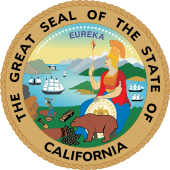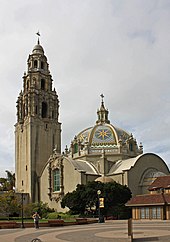California Pacific International Exposition half dollar
[1] At that time, commemorative coins were not sold by the government—Congress, in authorizing legislation, usually designated an organization which had the exclusive right to purchase them at face value and sell them to the public at a premium.
[4] John J. Cochran of Missouri, acting chairman of that committee, reported back to the House on April 12 with the recommendation that it pass after small technical amendments were made.
Cochran noted that Congressman Burnham had appeared before the committee, representing that there would be no expense to the government, and sent a letter so stating (reproduced in the report).
Burnham had also written that the Exposition had considerable participation by the federal government, and its officials expected seven to ten million people to attend.
[7] On April 23, the committee, through its chairman, Duncan U. Fletcher of Florida, recommended that the bill pass, with a report similar to that of the House.
[10] California Senator William G. McAdoo, former Secretary of the Treasury under Woodrow Wilson, wrote to the incumbent Treasury Secretary, Henry Morgenthau, proposing that the late president appear on the half dollar; Morgenthau wrote back calling the idea "interesting" and suggested it be directed to the Exposition Commission, which was responsible for securing designs.
[12] Sculptor Robert Aitken, creator of other commemorative coins including the $50 Panama-Pacific issue, was hired to design the California Pacific half dollar.
He submitted plaster models to the Commission of Fine Arts, charged by a 1921 executive order by President Warren G. Harding with making recommendations regarding public artworks, including coins.
[13] After final approval, the models were shipped to the Medallic Art Company of New York for reduction to coin-sized hubs, which were then sent to the Philadelphia Mint, where the working dies were made.
The name of the exposition surrounds the design, with the date, IN GOD WE TRUST (under which the mint mark is found) and SAN DIEGO among the buildings.
He felt the depiction of the buildings on the reverse was "good enough for what it pretends to show", and noted that the monogrammatic style of the artist's initials was imitated by Gilroy Roberts when signing his obverse of the Kennedy half dollar (1964).
[22] On February 17, the committee reported back through New York's Andrew Somers, noting that the bill provided that the exchange would take place without expense to the United States, and recommending that it pass.
[27] As the two versions passed were not identical, the bill returned to the House of Representatives where, on April 27, that body at Burnham's motion, without debate or opposition, agreed to the Senate amendments.
[34] On January 27, 1937, Davidson wrote to the Director of the Mint, Nellie Tayloe Ross, asking her to allow the return of some 150,000 coins for refund, the glut blamed on having a relatively short period to sell them.
Once the Mint had granted permission, the Exposition Commission placed the 1935-S and 1936-D pieces it withheld from the melting pot on sale at $3 each.
Large hoards of both dates were held by insiders for decades, including one holding of 31,050 of the 1935-S, amounting to nearly half the extant mintage.




